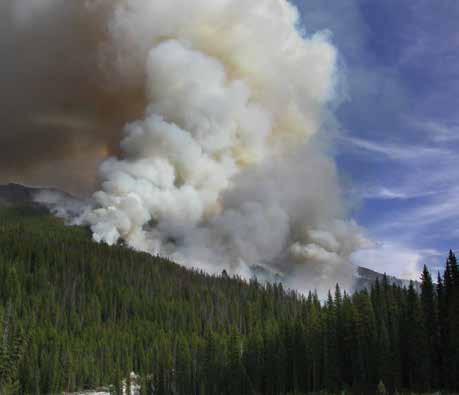
26 minute read
to Detect Fire Patterns Pg
FUSING SATELLITE IMAGES TO DETECT FIRE PATTERNS
Nicholas Leach
Advertisement
The 2017 fire season burned massive swaths of forest across British Columbia and the rest of the Pacific Northwest. It was a historic fire year, with more forest burned than any other year on record. But, that record only lasted a single year: in 2018, an even greater area of BC’s forest burned. In order to understand the true environmental effects of these increasingly severe wildfires, new tools are needed to rapidly detect and map the areas that they burn.
Solving this challenge formed the basis of my research with the Faculty of Forestry’s Dr Nicholas Coops as we uniquely combined satellite data sets to study forest fire burn patterns. As fires spread, they leave distinct patterns on the landscape. The severity, shape, size, and timing of these patterns are important indicators, each holding pieces of information about how the ecosystem has been affected and how it may respond. In forest ecosystems where fires are the dominant disturbance, these pattern indicators also serve as a template for forest management practices which aim to emulate natural forest cycles.
In the days, weeks, and months after a fire, weather and vegetation regrowth begin to obscure these spatial patterns. Rather than attempting to survey the burned areas in person, satellite imagery can be used to efficiently capture the fire patterns at scales ranging from small individual burns to nationwide maps. However, in practice, finding the right images acquired at the right time can prove challenging. Imagery that is too coarse misses the small but critical details, like unburned patches dispersed within the burned perimeters. Imagery too fine in scale often lacks the revisit rate to capture the fires multiple times before their patterns begin to fade. To further complicate the issue, smoke and clouds can result in gaps in usable imagery for weeks or months.
Swarms of miniature satellites, called CubeSats, help resolve this issue in a unique way. Dozens of these miniature satellites orbit the earth like a string of pearls, snapping images one after another. Taken together, they capture the entire surface of the earth nearly every day with high resolution cameras. Rather than being forced to choose between imagery that is detailed but infrequent and imagery that is frequent but has limited resolution, CubeSats offer the best of both scenarios, frequently delivering detailed imagery.
However, the sole use of CubeSats imagery presents certain drawbacks. When it comes to quality, miniature satellites can’t compete with their heavyweight cousins. Subtle but important properties, like the consis
tency between subsequent images, suffer in CubeSat imagery. In order to conduct a deep analysis of burned areas, ideally imagery from both CubeSats and conventional satellites would be combined.
My recent research focused on fusing these datasets in order to study forest fire burn patterns with an unprecedented combination of resolution, timeliness, and sensor performance. Together with Tanka, a Vancouver-based start-up, I developed software which automatically takes CubeSat images and, using imagery from the Sentinel-2 and Landsat satellites, ensures that each one is precisely calibrated to each CubeSat image. This makes it possible to examine how each pixel behaves through time, detecting both sudden and gradual changes in the condition of the vegetation. Simultaneously, I estimated spatial pattern indicators, including the complexity of the burn’s perimeter and the number of unburned patches within the greater burn area.
Thanks to the support from Tanka, Nikola Obrknezev, and the Natural Sciences and Engineering Research Council (NSERC), through my research I found that some key indicators of fire patterns are sensitive to the properties of the satellite imagery used to measure them. Considering that these indicators help predict ecosystem behavior after fires and influence forest management and harvesting practices, it is critical to ensure that our understanding of them is as accurate as possible. By fusing together the best available satellite images into a powerful new and unique dataset, we can make significant steps forward in improving our understanding of the behavior and importance of wildfire on BC’s landscape.
Nicholas Leach is a data scientist at Tanka Building Products. He can be reached at nicholas.leach@alumni.ubc.ca.
ISLAND WILDFLOWER RAPIDLY ADAPTS TO DEER PRESENCE Cora Skaien and Peter Arcese
Cora Skaien conducting surveys of seablush inside one of the exclosures on Sidney Island
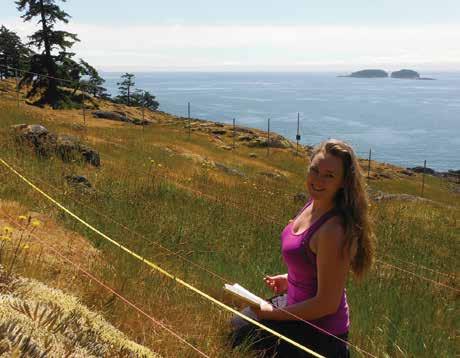
Can plants outrun environmental change? The answer is both yes and no. Perhaps the Red Queen’s advice to Alice in Lewis Caroll’s Through the Looking Glass describes it best: “… you see, it takes all the running you can do, to keep in the same place.”
This advice is fitting when looking at the thousands of species facing environmental change – they must either run as fast as they can to adapt to those changes without seeming to actually make progress; go elsewhere; or become extinct. For biologists, it means that they must race to estimate the capacity for rapid adaptation in a species of interest and then build those findings into conservation plans.
The overpopulation of deer on the Gulf and San Juan Islands of British Columbia and Washington State has been a concern studied by biologists over many decades. The removal of native predators, such as cougars, bears, and wolves, and more recent restrictions on human hunting, including bans on many large islands, have both contributed to the population growth of deer on large islands. As a result, browsing pressure – feeding by herbivores such as deer on leaves, shoots, and plants such as shrubs – has become unsustainable for many species throughout most of the region, despite first being reported as an issue by Ian McTaggert-Cowan in the 1950s, and more intensively documented over the last two decades by researchers from the University of British Columbia, including our team’s recent work.
Many ecosystems now at risk of being lost in our region were once maintained by Indigenous Peoples who practiced sustainable harvesting of plant and animal species and, as a consequence, contributed positively to the persistence of our coastal Douglas-fir, Garry oak, and Maritime meadow ecosystems which are now under threat.
Despite the recent extinction of dozens of culturally and biologically significant plant species from many Gulf and San Juan Islands, and the dramatic simplification of bird and pollinator communities, there are also glimmers of hope. The findings of our recent study of seablush (Plectritis congesta) – a wildflower of endangered Garry oak ecosystems – from 12 island populations, offer one such glimmer. Our findings indicate that seablush appears to demonstrate a particularly remarkable ability to evolve rapidly in response to browsing by deer. This led us to ask: are this species’ defenses enough to enable it to survive the presence of overabundant deer, or would those defenses be overwhelmed causing it to become extinct? A focus on seablush allows us to also consider parallel questions facing hundreds of specialist plants endemic to the federal Species at Risk Act (SARA) – listed ‘‘Garry Oak and Maritime Meadow ecosystems” in Canada.
We have observed that seablush is a species that appears to be locally adapted to deer presence, by virtue of its stature, growth form, flower size, and seed type. Our findings were demonstrated by maintaining large exclosures on Sidney Island with over 3,000 plants from 12 populations that either coexisted with deer or existed without them. The seablush were planted in and outside of exclosures, either exposing them to or protecting them from the deer.
Our results indicated seablush populations varied in size depending on whether or not they had been historically exposed to deer. Seablush presents as a diminutive plant just centimeters tall from areas where deer are common. While on islands without deer for 30 or more years or without exposure from the pollen of plants on islands with deer, seablush presents as a showy plant sometimes reaching over a metre in height. By constructing “common gardens” of many populations grown together at UBC’s Totem field, we demonstrated how seablush
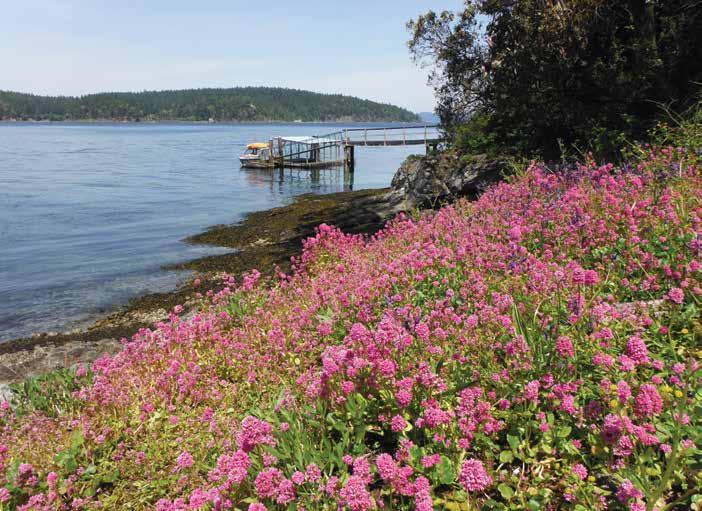
Seablush often dominates Garry oak and Maritime meadows when deer are absent, such as seen here on a Southern Gulf Island
populations have likely co-evolved with deer in ways that allow it to survive and reproduce at high rates by remaining small early in the season and producing more but smaller seeds. By comparison, “naïve” plants from islands with no history of deer being present, bolt earlier, grow taller, and produce dramatically showier flowers with larger but fewer seeds.
By pairing these experiments with the results of others which imposed artificial selection on plant height to simulate browsing with scissors, we know that seablush populations can double in size, or become half as tall, within just five generations. While that clearly qualifies as rapid adaptation, we also show that browsing by deer drove all populations extinct within three years in the absence of protection on Sidney Island.
This leads us to conclude that while seablush is clearly capable of rapid adaption in response to environmental change, it remains vulnerable to extinction where deer populations have become hyper-abundant – an outcome that would likely never have happened historically due to mortality from large predators and Indigenous hunters who maintained these diverse ecosystems via their land stewardship activities. We suggest that learning how to reinstate Indigenous practices and traditional knowledge in southwestern BC will be critical to stopping biodiversity declines in Garry oak and Maritime meadow ecosystems and in restoring extirpated species where possible.
Dr Cora Skaien is a recent PhdD graduate and can be reached at cora. skaien@ubc.ca.
Dr Peter Arcese is a professor at the Department of Forest and Conservation Sciences and is the UBC Faculty of Forestry’s Forest Renewal Chair in Conservation Biology. He can be reached at peter.arcese@ubc.ca.
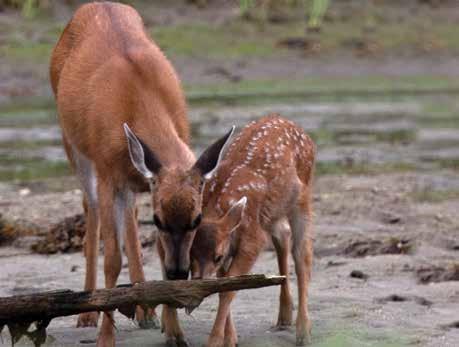
Deer are often overabundant in the Southern Gulf Islands of BC, due to removal of predators. Plants in this region must either evolve to tolerate deer browsing, or go extinct
MULTIDISCIPLINARY UBC TEAM DEVELOPS BIODEGRADABLE MEDICAL MASK
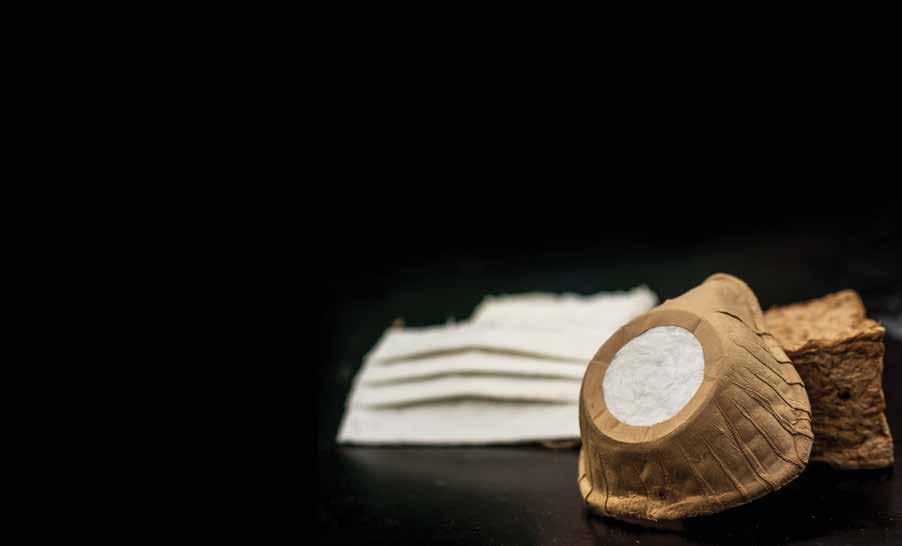
Orlando Rojas
When arriving at the University of British Columbia in January, as the scientific director of the Bioproducts Institute, I never imagined that only a few months later, we would be in the midst of a global pandemic, and that by May, I would be co-leading a team responsible for developing what is believed to be the world’s very first fully biodegradable medical mask prototype.
Since the initial stages of the pandemic, disposable mask litter is apparent all around us. Masks and gloves are polluting the sidewalks and could eventually enter our rivers and oceans. To meet the growing demand of healthcare professionals, a solution was needed urgently – ideally one that was cost-effective, using local sourcing and biodegradable materials, helping mitigate the masks’ environmental impact.
Solving these types of challenges very much fits the vision of the Bioproducts Institute, which brings together inter- and multi-disciplinary teams of researchers comprised of scientists and engineers to unlock the full potential of materials, chemicals, and energy produced in nature, including creating high-performance materials from renewable resources.
Together, Johan Foster – chemical and biological engineering associate professor and NSERC Canfor Industrial Research Chair in Advanced Bioproducts – and I began pulling together a UBC team from the institute and beyond. Our outreach received overwhelming support, spontaneously generating the assistance of researchers in forestry; chemical and biological engineering; mechanical engineering, chemistry; and medicine. We assembled in-house expertise in the areas of complex fluid, fibre processing, surface chemistry, nanotechnology, and additive manufacturing.
The success of developing the “Canadian-Mask” or “Can-Mask” in a matter of weeks was only possible due to the years of research and expertise from the Bioproducts Institute, and the Pulp and Paper Centre, as well as our recent work with Aalto University and the Finnish Research Center (VTT). These organizations are leaders in techniques such as 3D forming of paper by applying heat and pressure, and foam forming – which is used to create light-weight porous materials. My previous experience with nonwovens at North Carolina State University’s Nonwovens Institute, was also instrumental since we worked on several projects related to the adoption of bio-based materials in advanced textiles.
While a mask for air filtration appears to be a simple task, multiple functions of the frame and filtration media require the use of advanced technologies. A unique aspect of the project was the involvement of undergraduate students in the initial design process. Within a week, we received 12 submissions reflecting various proposals for different aspects of the design ranging from how to make the straps to how to make the mask take the shape of one’s face. These contributions helped inform the broader design considerations.
Our Can-Mask prototype is comprised of two key components: the passive and the active. What is innovative about our design is combining all of these ideas and making a system
that is the first of its kind.
The passive component is the non-permeable mask frame which is designed to provide protection while also holding the filter in place. It must conform to the human face and must be flexible enough to adapt to a range of people. Other considerations include how it feels on the skin; how it fits; and of course, how it looks. It is made entirely from BC wood fibres from sources such as pine, spruce, cedar, and other softwoods.
Our prototype for the mask frame can be produced by two methods using cellulose fibres – thermoforming and wet-laying. The wet-laying process is similar to papermaking – using a screen in the shape you want to make, you lay the wet fibres on the screen and as they dry, they take the pre-designed form. For this, we have used different designs produced by 3D printing. Paper is very adaptable, enabling us to add wet strength and anti-microbial agents, as well as a moisture barriers to help with the mask’s performance.
For the active component, the preferred option uses a biomass-based filter specially designed by our team. By using the foam-forming process, a competitive level of filtration performance is developed by suspending the fibres into unique, porous structures, creating a low-density material. It is essential to create a permeable network of fibres that lets air in but filters out 95% of very small (0.3% micron) particles. Other performance criteria our team has addressed include protein resistance for medical use, water and oil resistance, and fire retardancy.
Currently, we are evaluating the prototypes that we have. At this point, we know it works as a filter and is breathable. The question is: does it fulfill the high standard of an N95 mask? To make it truly superior in performance, it needs to electrically trap any charged particles in the air, including the virus. In-house visualization techniques, including tomography tests are currently underway. Following our testing to ensure the masks meet health industry specifications, we will consider certification.
In reflection, I am extremely grateful for the tremendous support and the many long hours the UBC community – students, faculty, and staff – invested to develop the CanMask prototype. A project of this magnitude and impact is accelerated with a multidisciplinary approach. We are also grateful that UBC granted special lab access so we could continue this work while observing all health and safety protocols.
Never in our lives have we faced a crisis with such profound health, social, economic, and environmental impacts. If COVID-19 has taught us anything, it is how important it is to have a robust supply of protective equipment like N95 respirators and medical masks. It is very exciting that the CanMask provides an example of the opportunities for materials to be locally-sourced, while being biodegradable; it also demonstrates the potential for our forest resources and forest products industries to fulfill the material needs of the future.
Dr Orlando Rojas is the Canada Excellence Research Chair in Forest Bioproducts and the scientific director of the Bioproducts Institute at UBC. He is a wood science professor with the Faculty of Forestry. He is also a professor with the UBC departments of chemical and biological engineering. He can be reached at orlando.rojas@ubc.ca.
Johan Foster (left) and Orlando Rojas (right)
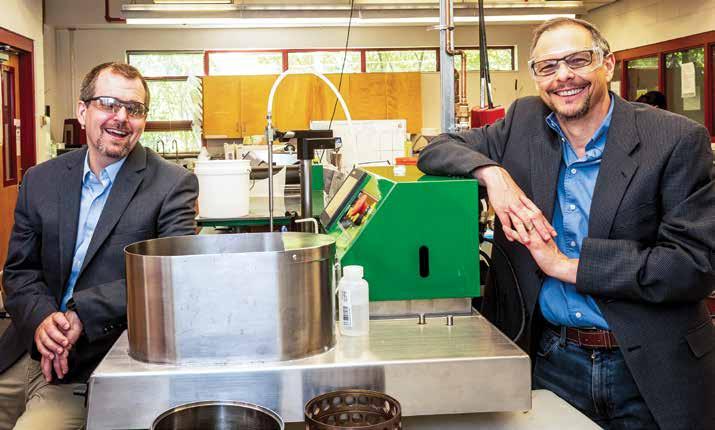
news development & alumni
MATT WEALICK RECEIVES UBC ALUMNI BUILDER AWARD
Each year, alumni UBC recognizes outstanding alumni across all faculties who have enriched the lives of others and significantly contributed to the University of British Columbia. In 2019, the Faculty of Forestry nominated Matt Wealick, BSF 2001, RPF, for the Alumni Builder Award in recognition of his strong engagement and support of the Faculty and contributions to First Nations forestry issues.
Matt has maintained a strong and deep connection to the Faculty since graduation, most recently as co-chair of the First Nations Council of Advisors. He also serves as a Board Member and Chair of the Aboriginal Affairs Committee for the Truck Loggers Association.
As a Sto:lo person and a member of the Tzeachten First Nation of the Chillwack Valley, Matt’s career has increasingly focused on First Nations forestry over the years. “When I started at UBC I came from an industry background as an everyday forester, with no idea what First Nations forestry was about,” he says. “There were only 10 or 12 aboriginal students in the faculty at that time. Now it’s quite a bit different of course.”
After graduating from UBC Matt went on to receive a Master of Science in Environment and Management from Royal Roads University and received his RPF designation. He built his career gradually, first as a planning and operations forester, then as an engineering supervisor and then as an operations manager.
After returning to Chilliwack in 2005, Matt was appointed manager of the Ts’elxwéyeqw Forestry Limited Partnership, giving him the opportunity to build a forest company from the ground up. Not only did Matt manage every conventional aspect of the business, he worked in areas that are specific to First Nations forestry, like rights and title, traditional and cultural use, and capacity building.
When the Ts’elxwéyeqw Tribe reorganized its corporate structure to create a management company, Matt became the Chief Operating Officer, overseeing six businesses and managing five forest licenses.
In 2013, Matt received an Aboriginal Business Award for the Joint Venture Business of the Year, for his work at Ts’elxwéyeqw Tribal Management.
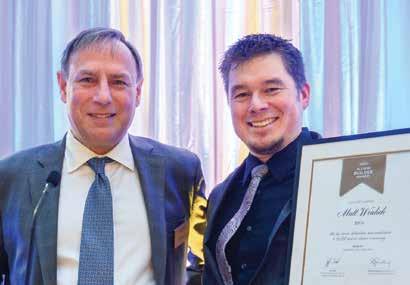
In 2017, Matt established his own consulting company called Spa:th Strategies. His business focuses on providing unique solutions to the challenges of managing First Nations forest tenures. “I’m using everything I have learned up until now to help First Nations successfully incorporate their cultural values into their management plans,” he says. “For example, if you take a sanctuary area in a forest, the objective is peace and tranquility. So how do we manage the cut allowance to ensure that we meet the objectives for wildlife preservation, fisheries management, and aboriginal spiritual values? This can be done in a way that’s congruent with provincial government plans.”
Matt also gives his time as a volunteer to First Nations communities, serving on two Tzeachten committees and the Operating Board for the Heiltsuk Nation.
Matt’s message to current and future UBC Forestry students is clear: “This is a prime time for First Nations students to be involved in forestry, especially with the education you get from UBC. The industry is crying out for people who have an aboriginal background and know what their community’s needs are; they are valuable to industry and government,” he says. “There’s lots of work in the forest industry and natural resource management, so stick with it and push through. It will benefit us all in the end.”
The Faculty of Forestry congratulates Matt Wealick on receiving the Alumni Builder Award. If you have a great story about a Forestry alumnus or alumna, please let us know. Contact Michelle Lindsay at michelle.lindsay@ubc.ca or phone 604.827.0297.
ALUMNI SURVEY HIGHLIGHTS
As part of our expanded efforts to build stronger ties with our alumni, the Faculty conducted a survey this past fall to better understand the relationship our alumni have with the Faculty and gain their feedback.
We invited the 3,850 alumni that we have email addresses for to take part and we were overwhelmed by the response, with almost 1,600 alumni participating. The survey provided valuable information to help us develop our programs, inform prospective students about what their careers may look like, and better communicate with you, our alumni.
Here’s a snapshot.
Age by Generation
Gen X 1966-1980 27% Millennials 1981-1995 26% Younger Boomer 1955-1965 19% Older Boomer 1946-1954 11%
Matures Before 1946 9%
Gen Z After 1995 8%
Location
Professional designation
Lower Mainland 39%
None 53% Rest of British Columbia 32%
RPF 37% Outside of Canada 19% Elsewhere in Canada 10%
In process of receiving 6% RPBio 4% PEng 3%
Sector
Private Sector 46% Government/ Public sector 29%
Higher Education 12% Other 8% Not for Profit 6%
We received over 3,758 responses to our open ended questions that provided deeper insights and are exceedingly helpful at identifying trends and themes that will further improve our programs. Noted requests were: • Create stronger connections to industry and professional associations • Insure a clear pathway for students to achieve professional designations • Provide students with additional business and project management skills • Prioritize field work
Thank you to all those who took part.
FACULTY ESTABLISHES CHAIR IN CONSERVATION
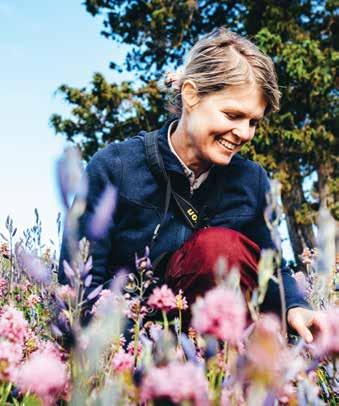
Dr Tara Martin, Professor in conservation decision science in the Department of Forest and Conservation Sciences, is the inaugural holder of the Liber Ero UBC Chair in Conservation. This new Chair is established through generous support from Val and Dick Bradshaw, with matching funds from the University of British Columbia.
Tara Martin is a pioneer in the field of conservation decision science: combining predictive ecological models with decision science to inform what actions to take, where to take them, and when, in order to achieve conservation and natural resource management goals. “My work is about the translation of data into ecological decisions,” she says. “We study the impacts of various pressures on biodiversity, then translate the data into predictive models that can assess the effectiveness of different management interventions to recover endangered species and ecosystems, including actions to adapt to climate change.” “Right now there are over 700 species at risk in Canada, and current approaches to conservation are failing. Decisionmakers are often investing in species with the lowest likelihood of recovery at the highest cost,” she says. “If we are likely to lose a species no matter how much we spend, we need to know this so we can use our resources more effectively and invest in recovering species with a greater likelihood of success.”
The new Chair in Conservation will allow Tara and her team to have consistent funding to support the work of translating data into actionable decisions. “Val and Dick Bradshaw’s financial support helped establish my position,” Tara says. “I’m very grateful to them and to UBC for allowing me to hold this Chair, which helps ensure consistent funding for our graduate students and the pioneering work we do.”
Val and Dick Bradshaw are philanthropic leaders in conservation research. In addition to the Chair in Conservation at UBC, they have established a Chair in Conservation Biology at McGill University, a Chair in Fisheries Research at University of Victoria, and a Chair in Coastal Management at Simon Fraser University. They have also established the two-year Liber Ero Postdoctoral Fellowship program that supports four conservation biologists annually.
Tara Martin was born in Canada to a Canadian mother and an Australian father, and has moved seamlessly between the two countries. She completed her undergraduate and graduate degrees in Australia, and received a PhD in Ecology from the University of Queensland in 2004.
She then did two years of postdoctoral research in the UBC Faculty of Forestry, after which she established the Conservation Decision Lab at the Australian national science agency CSIRO. In 2013 Dr Martin returned to Canada, and took up her position at UBC in 2018.
In 2018 Dr Martin’s research received national attention with a front-page feature article in The Globe and Mail. “That raised my profile immediately, and opened the doors to a number of important conversations about conservation in Canada at a national scale,” she says.
Priority Threat Management (PTM) is a key tool developed by Dr Martin and her colleagues. This decision tool identifies the threat management strategies that will recover the most species for the least cost, drawing on empirical data and expert knowledge of biodiversity threats, as well as the costs; feasibility; and benefits of management to species recovery.
To date, PTM has been applied to three study areas in BC, as well as regions in southwestern Saskatchewan, New Brunswick, one third of the Australian continent including the state of New South Wales, Indonesia, and Antarctica.
Dr Martin leads a team of 12 graduate students and postdoctoral fellows. “The mentoring of the next generation of conservation leaders is a huge motivation for what I do,” she says. “These brilliant minds will become leading conservation researchers and practitioners at universities, conservation NGO’s, government agencies, and industry bodies.”
The Faculty of Forestry is deeply grateful to the Bradshaws for their support of this important conservation research. For more information, or to explore your opportunities to support research in the Faculty, please contact Emma Tully, emma. tully@ubc.ca or phone 604.822.8716.
MEET THE DEVELOPMENT AND ALUMNI ENGAGEMENT TEAM
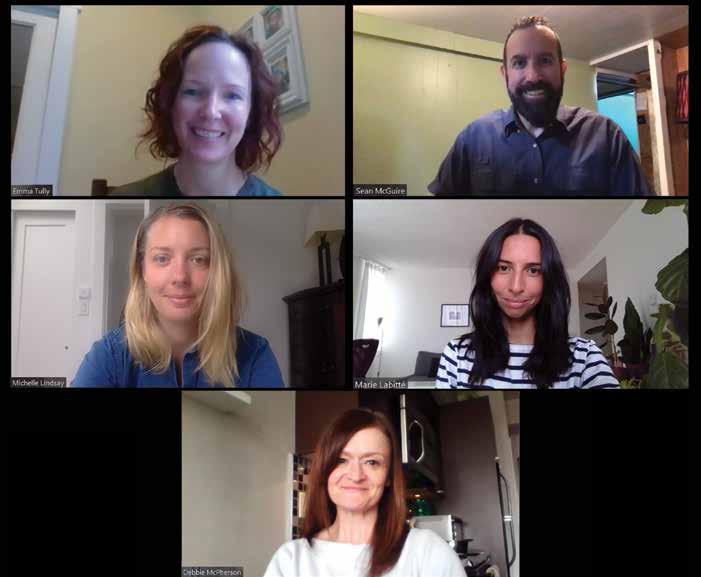
The five members of the Development and Alumni Engagement team in the Faculty of Forestry are a passionate and dedicated bunch. They work to ensure that the Faculty has the resources it needs to support priority projects in student learning, research, and engagement with alumni and the corporate community.
OK, but what do they really do? And what do they think about it? How did they end up in Forestry? Do they have any fun? We wondered; we asked; they answered.
Tell me about your job.
Emma Tully, assistant dean, development and alumni
engagement: I am part of the Faculty’s management team and I oversee the fundraising and alumni engagement programs. I am a link between the Faculty and the community – engaging with donors, alumni, organizations, associations, and industry to find meaningful ways to connect them with the Faculty.
Marie Labitté, development officer: I’m a front-line fundraiser. I seek financial support for the Faculty to offer excellence in teaching and research, strengthen our community engagement, and provide students with the best possible learning environment.
Sean McGuire, development officer: I have the same job as Marie. We also develop relationships with our alumni and connect them with opportunities for volunteering and raising financial support.
Debbie McPherson, development coordinator: I’m the back end support for the team. I manage administrative duties such as reporting, meeting preparation, financial processing, donor stewardship and recognition.
Michelle Lindsay, alumni engagement manager: I’m the first contact for our alumni and it is my responsibility to keep them engaged with the Faculty. I produce the alumni newsletter, run events, and answer alumni requests.
Where do you come from?
Marie: I come from a small farm in Normandy, France. My partner and I moved to Canada in 2012. After spending three years in Toronto, we moved to Vancouver. In 2015,
working in finance, I decided to use my skills for something I was truly passionate about: forest ecosystems.
Debbie: I am the fourth generation of my family to be born and raised in Victoria. I graduated from Camosun College in hospitality and worked for many years at the Empress Hotel and on cruise ships. Then I moved to Vancouver, and 12 years ago began working as a temp in the Dean’s office. I joined the DAE team seven years ago.
Michelle: I completed a recreation diplomat at Langara College and graduated from Royal Roads University with a commerce degree. I started my not-for profit career working at the Rick Hansen Foundation for six years.
What do you most enjoy about your job?
Emma: The people: their stories tell us that our work really has an impact by supporting research and student learning experiences that might not otherwise be possible. Our job is to help connect donors with the great work taking place at UBC, and what could be better than that?
Michelle: The people! I love getting to know our alumni. Learning about their connection to the University, the skills that they gained, and the friendships that they formed is a joy.
Marie: Helping our supporters fulfill their own aspirations and achieve our shared vision for forests. Building and fostering a strong, inclusive community of supporters for our Faculty and our forests.
The field of forest operations in Canada is rapidly changing, the discipline has evolved significantly, and today’s forest operations have become a bridge-builder between different disciplines to support sustainable forestry practices in Canada.
The first webinar of our Faculty of Forestry Series, hosted by Dr Sally Aitken, featuring Dr Dominik Roeser, Professor in the Department of Forest Resources Management can now be found online.
How much did you know about forestry before joining this team, and what have you learned?
Debbie: While I don’t have formal forestry education, my family has a long history in the forest industry. My grandfather ran a logging machinery company in Victoria and his father was a logger and wood carver. Some of my great-grandfather’s work is in the ceiling of the Q Bar in the Empress Hotel in Victoria.
Sean: I grew up in BC and spent much of my time in the forests and mountains so I feel very connected to this ecosystem. My wife is an ecologist (she received her PhD from UBC) whose research was focused on the west coast and it has been great to learn from her. Over the years, I continue to enjoy and learn about our forests and other natural resources.
Emma: I’ve learned a lot over the past nine years with the Faculty, thanks to being surrounded by some of the world’s leading experts in the field. In our roles we need to translate complex research topics into language a broader audience can understand and get behind. My rule of thumb is: if I can understand it, then everyone else will too.
The Development and Alumni Engagement team is here for you! If you’d like to share a story, get some information, or become involved as a volunteer or donor, please contact us. https://support.ubc.ca/category/projects-by-faculty/
faculty-of-forestry/.
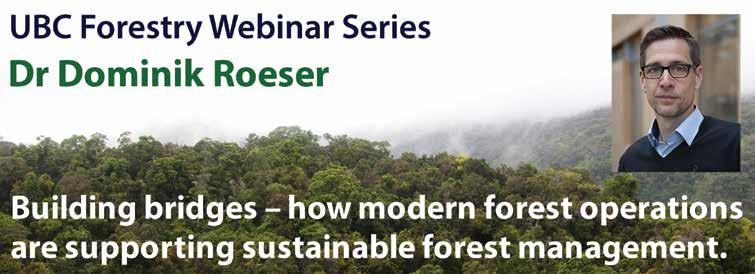
Return undeliverable Canadian addresses to:
Faculty of Forestry University of British Columbia Forest Sciences Centre 2005 – 2424 Main Mall Vancouver BC CANADA V6T 1Z4
Dr Roeser’s presentation provides a vision for forest operations of the future and features recent research highlights in forest operations at UBC. Highlights of the presentation include virtual reality in operational planning, fuel supply for small-scale combined heat and power installations, safety in steep slope harvesting, and a pathway to more commercial thinning operations in BC. https://support.ubc.ca/?post_type=contacts&p=2480.

